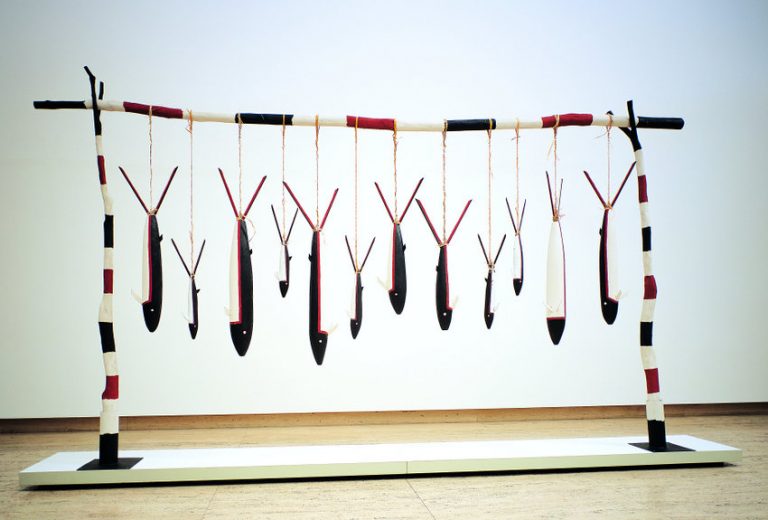We acknowledge the Traditional Owners of the land on which the Queensland Art Gallery | Gallery of Modern Art stands and recognise the creative contribution First Australians make to the art and culture of this country.

Arthur Koo-ekka Pambegan Jr / Wik-Mungkan people / Australia 1936–2010 / Alair Pambegan (collaborating artist) / Wik-Mungkan people / Australia b.1966 / Bonefish Story Place 1994, reworked 2003 / Carved milkwood (Alstonia muellerana) with synthetic polymer paint and natural pigments / 15 components: 280 x 650 x 50cm (installed, approx.); five bonefish: 50 x 25cm (each); seven bonefish: 100 x 30cm (each); 2 poles: 300 x 20cm (diam., each); crossbar: 20 (diam.) x 500cm / Purchased 1995 with a special allocation from the Queensland Government. Celebrating the Queensland Art Gallery’s Centenary 1895-1995. With additional components commissioned 2002 with funds from the Queensland Art Gallery Foundation Grant / Collection: Queensland Art Gallery | Gallery of Modern Art / © Estate of Arthur Koo-ekka Pambegan Jr and Alair Pambegan
Arthur Koo-ekka Pambegan JrBonefish Story Place 1994–2003
Not Currently on Display
Bonefish Story Place tells the story of two brothers who walked from the tip of Cape York looking for a place to make a home, finally settling at the end of the Small Archer River, which is the country where Arthur Koo-ekka Pambegan Jr was born.
The brothers fought over a young woman and the older brother was killed. The younger brother regretted his actions and went into the river where his sibling had fallen. Neither returned. According to the story, they turned into bonefish, which are silver fish that live in the shallow tropical waters.
These sculptures were carved from milkwood, when the tree is green and soft. After the bark is removed with a small axe, copious amounts of milky white sap are left to run out. The logs are then shaped and painted Wik-Mungkan patterns in colours derived from ochre and charcoal.
An elder of the Wik-Mungkan people, Arthur Koo-ekka Pambegan Jr lived in Aurukun, a small Indigenous community on Queensland’s Cape York Peninsula. Pambegan grew up in Aurukun at a time when the Presbyterian mission regulated daily life.
He was raised in the boys’ dormitory, separated from his parents, until he was old enough to work, variously, as a pearling diver, timber and canecutter, ringer (cattle drover), yardman and housepainter.
Arthur’s father, Arthur Pambegan Sr, was also a highly respected elder, who taught him traditional knowledge and the carving techniques used in his ceremonial sculptures.
Discussion Questions
1. What lessons for living can be drawn from the Bonefish story?
2. Discuss the materials used and the structure of this artwork. What artistic decisions has the artist made in creating this work (i.e. scale, colour and pattern)?
3. Red bauxite cliffs and white sandy beaches are symbolically referenced. These patterns are used to decorate carvings, tools, bodies and, in recent years, canvases. What understandings of country and place can be inferred through their repetition?
Classroom Activities
1. Think of a lesson that you have learnt through an older person in your family. Develop a visual and/or spoken story to ensure that this lesson can be shared with younger people in your family.
2. Look at the bones of a variety of fish and discuss how the skeleton of these animals assist them as they glide and dart in the water. Practise drawing simple and complicated fish shapes and discuss concepts such as symmetry and balance. Bend and twist wire to create a fish shape similar to your drawing. Carefully insert the shape into a stocking or tight and once secured, cover with papier-mâché and hang on a rack to dry. Paint your fish with colours you’ve discovered from your research. As a class, think about how you could display them.